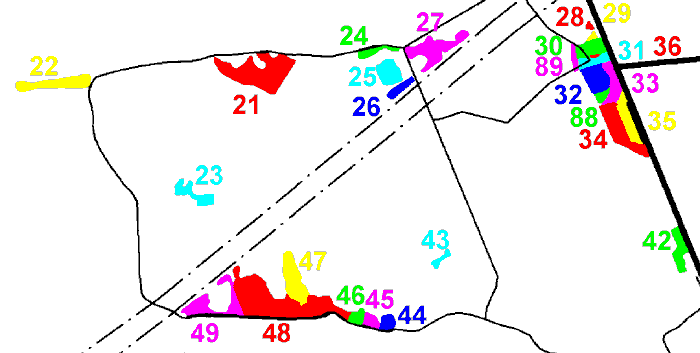
| 21 | sugar maple: planted at 3 m spacing, fewer than 50% survive, many badly forked near ground, best are 14 cm DBH, 11 m tall. |
| 22 | butternut |
| 23 | cottonwood: 18 cm DBH, 12 m tall |
| 24,26,27 | eastern hemlock: planted at 3 m spacing, many have two trunks, best are 15 cm DBH, 8 m tall. |
| 25 | Douglas fir: none survive. |
| 28 | western catalpa - none survive |
| 29,30,31 | bur oak: planted 1.5 m apart in 3 m spaced rows, 15 cm DBH, 12 m tall, self-pruning to 3 m spacing. Some encroaching speckled alder was removed from the western edge, some buckthorn from the roadside edge. |
| 32,33,36 | red oak |
| 34 | yellow birch: planted at 3 m spacing, ~30% survival, 12 cm DBH, 8 m tall, many badly forked or multistem, most leggy due to competition from invading white-gray hybrids. The yellow birch would benefit from the removal of the hybrids that are bent to the ground by snow and ice. |
| 35 | white oak: 82 survive, the best (in the south half) are 16 cm DBH, 10 m tall. The north half was invaded by gray-white birch, which impaired the oaks' growth, then died and broke off many of the oaks when they fell. |
| 42 | American chestnut, bitternut hickory, black spruce. The chestnuts have all died from canker. |
| 43-45,48 | white pine: planted at 2 spacing, 16 cm DBH, 10 m tall |
| 46 | red pine: planted at 2 m spacing, 21 cm DBH, 16 m tall |
| 47 | jack pine: planted at 1.5 m spacing, 14 cm DBH, 11 m tall |
| 49 | white pine, white birch, trembling aspen, eastern cottonwood: cottonwood towers over the rest, pines are 11 cm DBH, 7 m tall; most trees are leggy and broken |
| 88 | pin oak |
| 89 | black oak |
